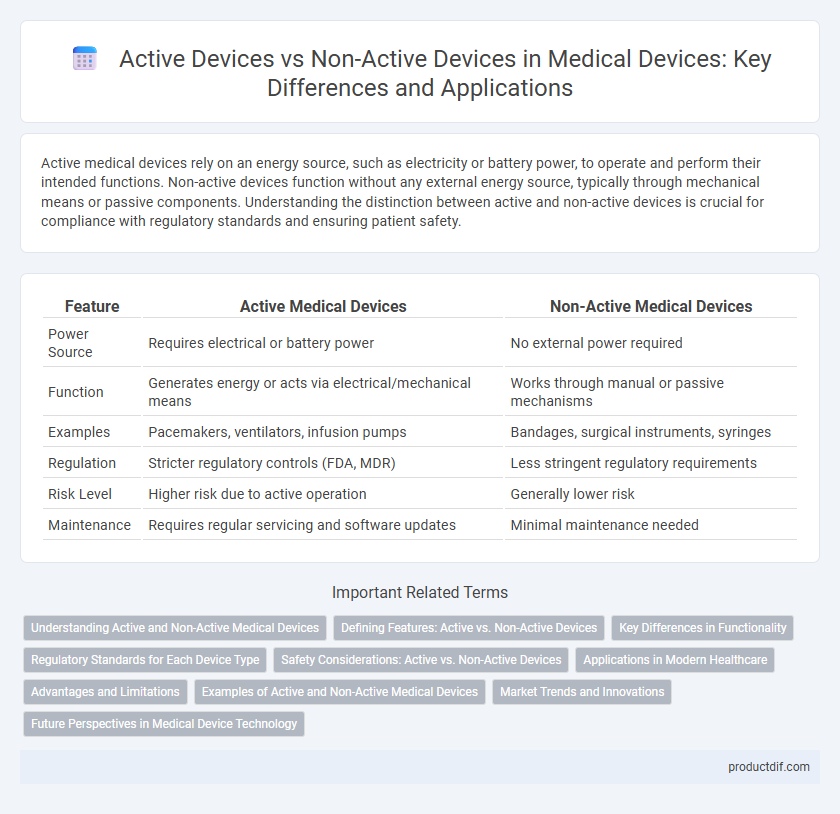Active medical devices rely on an energy source, such as electricity or battery power, to operate and perform their intended functions. Non-active devices function without any external energy source, typically through mechanical means or passive components. Understanding the distinction between active and non-active devices is crucial for compliance with regulatory standards and ensuring patient safety.
Table of Comparison
| Feature | Active Medical Devices | Non-Active Medical Devices |
|---|---|---|
| Power Source | Requires electrical or battery power | No external power required |
| Function | Generates energy or acts via electrical/mechanical means | Works through manual or passive mechanisms |
| Examples | Pacemakers, ventilators, infusion pumps | Bandages, surgical instruments, syringes |
| Regulation | Stricter regulatory controls (FDA, MDR) | Less stringent regulatory requirements |
| Risk Level | Higher risk due to active operation | Generally lower risk |
| Maintenance | Requires regular servicing and software updates | Minimal maintenance needed |
Understanding Active and Non-Active Medical Devices
Active medical devices rely on electrical energy or other power sources to perform their intended functions, such as pacemakers and infusion pumps. Non-active medical devices do not require external power and function through mechanical means, examples include surgical instruments and bandages. Understanding the distinction between active and non-active devices is crucial for regulatory compliance and ensuring patient safety during clinical use.
Defining Features: Active vs. Non-Active Devices
Active medical devices rely on electrical energy or other sources to perform their intended functions, such as pacemakers or insulin pumps, which use power to monitor and regulate physiological parameters. Non-active devices, including bandages and surgical gloves, function without electrical power, providing physical support or protection passively. Understanding the defining features of active versus non-active devices is crucial for compliance with regulatory standards and ensuring patient safety through appropriate device selection.
Key Differences in Functionality
Active medical devices rely on electrical energy or other sources to perform their intended functions, such as pacemakers or infusion pumps, whereas non-active medical devices do not require a power source and operate through physical or mechanical means, like bandages or surgical instruments. Active devices often include components like sensors, software, and batteries to monitor or regulate bodily functions, providing dynamic interaction with the patient's body. Non-active devices primarily serve as support or protection tools without electronic intervention, emphasizing simplicity and direct mechanical use.
Regulatory Standards for Each Device Type
Active medical devices, which rely on electrical energy or other sources to operate, must comply with stringent regulatory standards such as IEC 60601 for safety and performance. Non-active devices, functioning without external energy, are subject to standards like ISO 10993 for biocompatibility and fewer electrical safety requirements. Regulatory bodies like the FDA and EU MDR impose differentiated classification and conformity assessment procedures based on whether the device is active or non-active, ensuring appropriate risk management and patient safety.
Safety Considerations: Active vs. Non-Active Devices
Active medical devices, such as pacemakers and infusion pumps, require strict adherence to electrical safety standards to prevent malfunctions that could harm patients due to their reliance on energy sources. Non-active devices, including surgical instruments and bandages, focus safety measures on material biocompatibility and structural integrity to avoid adverse reactions or physical injury. Risk management protocols for active devices emphasize software reliability and electromagnetic compatibility, while non-active devices prioritize sterility and resistance to contamination.
Applications in Modern Healthcare
Active medical devices, such as pacemakers and infusion pumps, play a critical role in monitoring and regulating physiological functions by utilizing electrical energy. Non-active devices, including surgical instruments and prosthetics, provide essential mechanical support or physical intervention without electrical input. Together, these devices enhance diagnostics, treatment precision, and patient outcomes in modern healthcare settings.
Advantages and Limitations
Active medical devices offer precise monitoring and control through integrated electronic components, enhancing diagnostic accuracy and therapeutic outcomes. However, their reliance on power sources and complex technology can increase costs and maintenance requirements. Non-active devices provide simplicity, lower manufacturing expenses, and robust reliability but may lack the advanced functionality and real-time responsiveness of active devices.
Examples of Active and Non-Active Medical Devices
Active medical devices include pacemakers, infusion pumps, and ventilators that rely on electrical energy to perform their functions. Non-active medical devices encompass items such as surgical instruments, bandages, and thermometers, which do not require an external power source. Both categories are essential in healthcare, with active devices providing dynamic support and non-active devices offering passive assistance in diagnosis and treatment.
Market Trends and Innovations
The medical device market is experiencing rapid growth in active devices, driven by advancements in embedded electronics, software integration, and connectivity features such as IoT and AI-powered diagnostics. Non-active devices maintain stable demand due to their cost-effectiveness and regulatory simplicity but face innovation challenges compared to the dynamic evolution of active devices. Emerging trends highlight a shift toward smart active devices with enhanced data analytics capabilities, enabling personalized patient care and remote monitoring solutions.
Future Perspectives in Medical Device Technology
Active medical devices, such as pacemakers and infusion pumps, incorporate electrical or mechanical energy to perform their functions, enabling advanced diagnostics and therapeutic interventions. Non-active devices, including bandages and surgical instruments, rely on manual operation and material properties without energy input but remain essential for basic patient care. Future perspectives in medical device technology emphasize integration of smart sensors, AI-driven analytics, and enhanced biocompatible materials, driving the evolution of both active and non-active devices towards personalized, minimally invasive treatments with improved safety and efficacy.
Active devices vs Non-active devices Infographic

 productdif.com
productdif.com